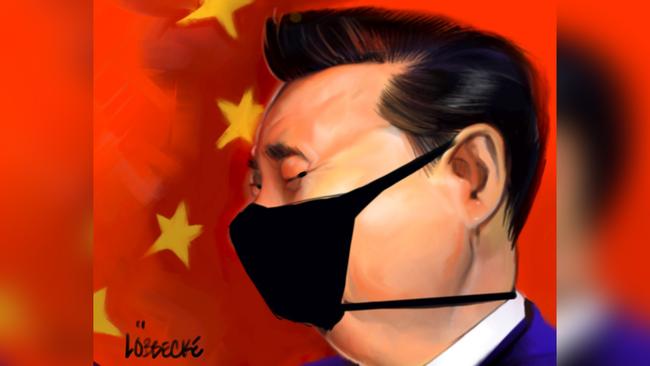
As governments and central banks scramble to restore confidence and support economic activity, the impacts of the coronavirus pandemic remain clouded in uncertainty.
What is clear is that the immediate shock is severe, both on the supply side — as Chinese production falls and global supply chains unravel — and in terms of consumers’ willingness and ability to spend.
Moreover, with commodity prices dropping and international tourism collapsing, the effects are spreading through the world economy far more quickly and acutely than the virus itself.
To say that is not to endorse the panic that has seized parts of the public. It is certainly true that COVID-19 is extremely dangerous. However, the reality is that none of the recent influenza pandemics has proven particularly long-lasting or resulted in the catastrophic fatalities that characterised the great pandemics of 1899 and 1918.
That is largely because the revolution in biology, which allows scientists to readily sequence and manipulate genetic structures, and improvements in medical care have eliminated the factors that made those earlier pandemics so prolonged and deadly.
Moreover, the very close biological similarities between this coronavirus and SARS, whose structure is now well understood, mean that a vaccine or highly targeted treatment could be developed quickly, though it would take several months for it to become widely available.
But, while COVID-19 is not the apocalypse, its economic consequences are likely to be far-reaching. At the heart of those consequences are the long-run implications for China, which has served as the locomotive of global economic activity for almost two decades.
That the crisis has highlighted the capabilities of the Chinese state is beyond doubt. It is inconceivable that any other regime could place up to 600 million citizens in lockdown, subjecting many of them to devastating income loss and to prolonged shortages of essential supplies, without facing a serious risk of revolt.
However, the pandemic has also brought the regime’s crippling weaknesses into stark relief — weaknesses that have been made more acute by President Xi Jinping’s drive to subject every area of life to Communist Party control.
Appointed all too frequently on the basis of cronyism and corruption, officials are neither willing nor able to efficiently deliver public services. Rather than recognising the difficulties that creates and confronting them, the incentives, throughout the regime, are to distort information and suppress whistleblowers, ensuring that problems fester until they spiral out of control.
And even then, the system’s complete arbitrariness in allocating rewards and penalties creates an atmosphere of distrust, which impedes the collaborative decision-making that allowed the “Asian tigers” — Korea, Singapore and Taiwan — to repeatedly overcome crises on their path to prosperity.
To make matters worse, the regime lacks any mechanism for effectively channelling and diffusing popular discontent. That this crisis, unlike earlier natural disasters, has severely hit the urban middle class compounds the pressures that creates. And, while the regime could calm public outrage in previous geographically circumscribed crises by loudly blaming local officials, the epidemic’s sheer scale has drastically undermined that tactic’s success.
The regime has therefore had to rely heavily on repression to secure compliance, compromising its legitimacy. As a result, there have, for the first time, been widespread echoes within China of the demands of the young protesters battling the police on the streets of Hong Kong. None of that implies Xi’s position is threatened, much less the survival of the regime itself.
Indeed, the obstacles confronting any attempt at mass unrest have increased as the regime’s instruments of social control have become all-pervasive. And far from weakening, Xi’s grip on power has tightened, with officials whose interests were not entirely aligned with his own being replaced by trusted henchmen.
It is, to that extent, an illusion to believe that China is at what political scientists call a “critical juncture” — a moment of great flux when established hierarchies are so thoroughly compromised that effective oppositions can form and coalesce — as was the Soviet Union at the time of the Chernobyl disaster.
But the regime that emerges from this crisis will be shaken by the experience, and so even more committed to bolstering the party’s sovereignty over economic, social and political decision-making, regardless of the high costs that imposes on growth.
The lesson many foreign firms draw from this crisis — that relying so heavily on Chinese suppliers is extremely dangerous — is likely to accentuate the slowing that causes, stymieing China’s ability to approach, much less overtake, the income levels its Asian counterparts achieved during their phase of high-speed growth.
The crisis could therefore prove to be a climacteric, signalling a scaling back in the world economy’s dependence on, and hence vulnerability to, China.
Seen from a global perspective, that is largely desirable. But it means the world economy must adjust simultaneously to a large transient shock associated with the immediate effects of the epidemic and to a structural slowing in China’s growth. And precisely because China has been so pivotal to global expansion, the impacts could be felt far and wide.
Thus, even before the epidemic, the eurozone was struggling. A further slowing could readily push Italy’s tottering economy over the edge, precipitating an Italian debt crisis whose scale would dwarf the resources and political mandate of the institutions the EU established in the wake of the Greek crisis. Whether the euro could survive such a crisis and, if so, at what cost, is an open question.
Nor are the fragilities confined to Europe. Almost everywhere, sharemarket valuations remain out of line with fundamentals, as do bond prices, debt levels are at (or are moving towards) historic highs, and political uncertainties abound. As the global adjustment plays itself out, another major correction in financial markets could therefore be on the cards, increasing the risks of recession.
Governments and central banks will want to reduce those risks. However, with interest rates already close to zero, monetary easing may only worsen distortions in asset markets. And it is obviously absurd to think monetary policy can address supply side disruptions, such as shortages of vital consumer products: central banks are the lenders of last resort of liquidity, not of toilet paper.
As for fiscal policy, experience shows that increasing spending is much easier than cutting it back — and few countries can afford another steep rise in public debt.
What firms and consumers need now, as they seek to map the transition from yesterday’s world to tomorrow’s, is calm, cautious and predictable policies that can be adjusted as the situation evolves.
The transition will be tough enough; it is up to governments and central banks to show that they won’t make the ride wilder than it has to be.





